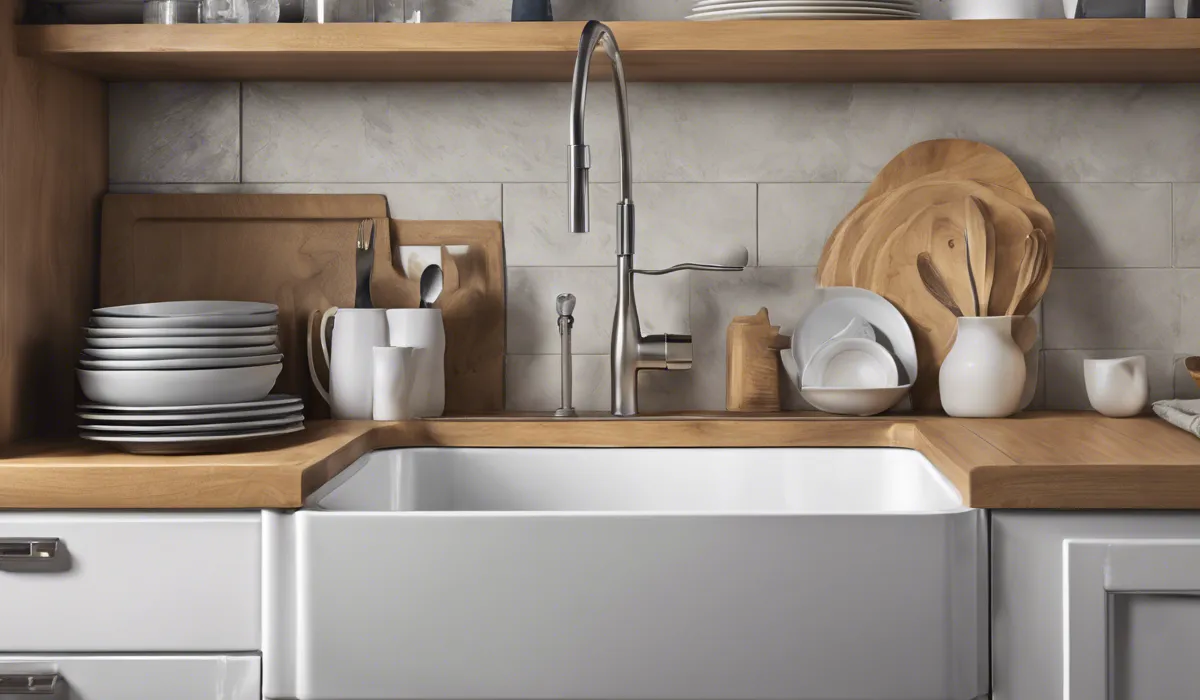How to Move Dishwasher to Other Side of Sink: Step-by-Step
To move a dishwasher to the other side of the sink, disconnect power and water supply, unhook drainage, and carefully slide out the unit. Reinstall opposite the sink, ensuring proper alignment with existing plumbing or extending connections as needed.
Assessing the New Location

Evaluating Space and Dimensions
When considering moving your dishwasher to the other side of the sink, your first step is to measure the new space. It is crucial to ensure that the dimensions match your dishwasher’s size.
Take into account not only the width and depth but also the height, especially if you have a countertop above.
Think about the dishwasher door’s clearance when opened and whether there is enough room for you to load and unload dishes comfortably.
Remember, a dishwasher that fits snugly into its new location will look better and function more efficiently.
Access to Water Supply and Drain Lines
Next, check the new location for access to water supply lines and drain pipes. These are essential for your dishwasher to function. If the existing plumbing on the other side of the sink isn’t suitable, you might need to extend the lines.
This can be a complex task and might require professional help. Additionally, make sure there is a proper shutoff valve for the water supply, which is crucial for maintenance and emergencies.
Availability of Electrical Outlets
Your dishwasher needs power to run. Check for existing electrical outlets within reach of the dishwasher’s power cord.
If there aren’t any, or if they are not correctly rated for your appliance, you may need to have new wiring installed by a licensed electrician. This ensures that the dishwasher operates safely and complies with local building codes.
Installation Guidelines and Adjustments
Review the manufacturer’s guidelines for relocating your dishwasher. These instructions provide valuable information on the installation process and any specific requirements.
Additionally, take note of any necessary adjustments that need to be made to cabinetry and countertops.
This might involve cutting new spaces or altering existing structures, tasks that might require precision and care to maintain the kitchen’s aesthetic appeal.
Preparing for the Move

Gathering Tools and Materials
Before starting the move, gather all the necessary tools and materials. You will need wrenches, screwdrivers, a level, a measuring tape, and possibly a drill.
Also, have some towels and a bucket handy to deal with any water that may drain from the hoses. Make a checklist to ensure you have everything you need before you begin, to avoid any unnecessary interruptions once you start.
Shutting Off Water and Power
For safety, shut off the water and power supply to the dishwasher. The power can typically be disconnected at the circuit breaker, while the water supply can be shut off via the dedicated valve under the sink.
Ensure that these are fully turned off to prevent any accidents or water damage during the move.
Disconnecting and Draining
Empty the dishwasher completely and proceed to disconnect it from its current location. This includes detaching the water supply line, the drain hose, and the power connection.
Once disconnected, carefully tilt the dishwasher to drain any remaining water from the hoses into a bucket, minimizing potential spills and water damage.
Protecting Floors and Surroundings
It’s vital to protect your floors and surrounding areas during the move. Lay down a protective covering, such as heavy-duty cardboard or drop cloths, to prevent scratches and dents.
If necessary, use furniture sliders under the dishwasher to help it glide across the floor smoothly.
Installing the Dishwasher at the New Location

Adjusting Water and Drain Lines
At the new location, you may need to adjust the water supply and drain lines to ensure they can connect to your dishwasher.
This could involve extending the lines or rerouting them for the best fit. Secure all connections tightly to prevent any leaks once the dishwasher is in use.
Electrical Wiring Considerations
If the new location requires additional wiring, comply with all safety codes and possibly hire a professional to do the work.
Ensure that the new outlet is accessible and provides the correct voltage and amperage for your dishwasher. Proper grounding is also critical to prevent electrical hazards.
Securing and Leveling the Dishwasher
Slide the dishwasher into its new location, ensuring it is snug against the cabinetry.
Check that the unit is level from front to back and side to side. Adjust the leveling feet as necessary to prevent operational issues and excessive vibration or noise.
Reconnecting and Testing
Reconnect the water supply, the drain hose, and the power. Make sure all connections are secure and there are no kinks in the lines that could impede water flow.
Turn the water and power back on and run a test cycle. Watch for any leaks and listen for unusual noises, addressing any issues immediately.
Finishing Touches
After ensuring the dishwasher operates correctly, make the final touches. This includes sealing any gaps between the dishwasher and cabinetry and reinstalling any removed pieces of cabinetry.
Check that the aesthetic integrity of your kitchen space remains intact, making any necessary adjustments to the surrounding areas for a clean and professional look.
FAQs About Moving a Dishwasher to the Other Side of the Sink
How do I disconnect power from my dishwasher before moving it?
Before moving your dishwasher, ensure the appliance is turned off, then disconnect the power by unplugging it from the wall outlet or switching off the circuit breaker.
What is the proper way to disconnect the water supply to a dishwasher?
To disconnect the water supply, first shut off the water valve under the sink, then unscrew the water supply line from the dishwasher using an adjustable wrench.
How can I unhook the drainage for my dishwasher?
Unhook the dishwasher’s drainage by loosening the clamp that secures the drain hose to the sink drain or garbage disposal and carefully removing the hose.
Can I extend the connections if the plumbing isn’t aligned with the new location?
Yes, if the existing plumbing isn’t aligned with the new location, you can extend the water supply and drain lines using extension hoses or pipes, ensuring they are properly secured and leak-free.
What should I be careful of when sliding out the dishwasher unit?
Be cautious to not damage the flooring and ensure that the dishwasher is level and balanced to prevent any strain on the connections or the unit itself as you slide it out.
Final Thoughts
To relocate a dishwasher, first ensure it’s disconnected from power and water supplies, then unhook the drainage.
Carefully slide the appliance out and reposition it on the opposite side of the sink, checking that it aligns with the existing plumbing. If necessary, extend the connections to accommodate the new location.





